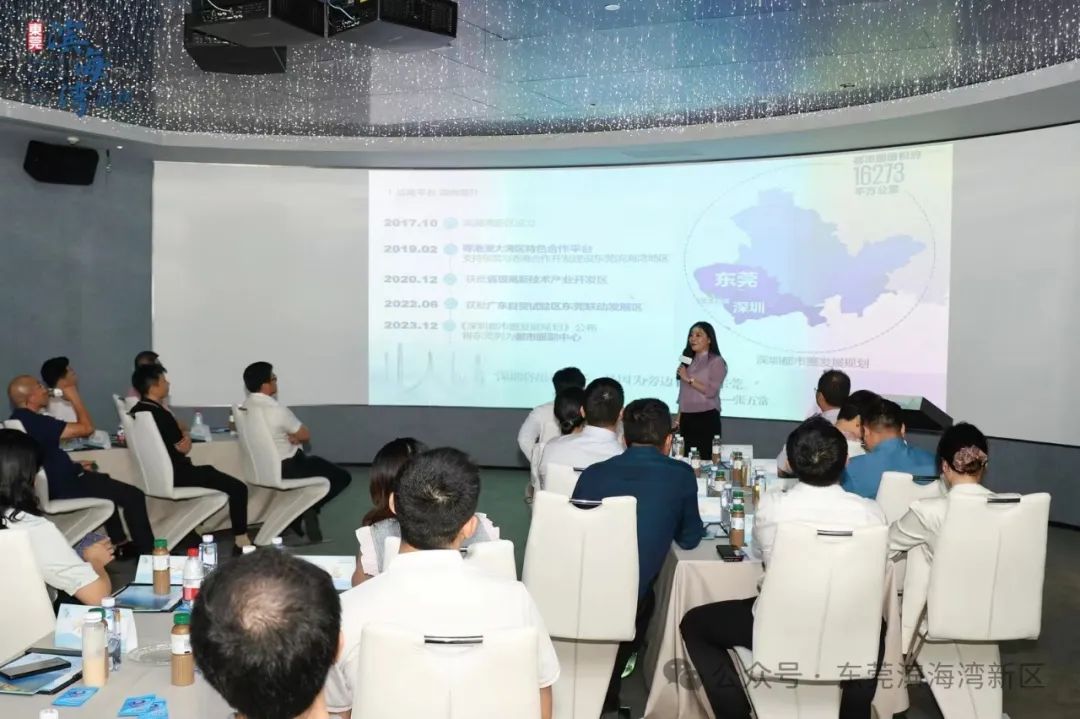On July 3, a group of leading enterprises from the intelligent mobile terminal and automotive electronics sectors visited the Binhaiwan Bay Area. They conducted on-site inspections of the area’s industrial ecosystem and supporting facilities, and held discussions to advance the implementation of key projects.
At the “Chip Chain Bay Area, Intelligent Binhaiwan” 2024 Dongguan Binhaiwan Bay Area Investment Cooperation Exchange Conference, Binhaiwan Bay Area introduced its investment environment and highlighted its advantages to a wide range of entrepreneurs. The conference decoded new opportunities for cooperation and development between high-quality enterprises and Binhaiwan. Sun Haibo, Deputy Secretary of the Party Working Committee and Director of the Management Committee of Binhaiwan Bay Area, attended the exchange conference and delivered a welcome speech.

Dongguan, known as the manufacturing capital, currently boasts over 200,000 industrial enterprises, including more than 13,000 above-scale enterprises and over 10,000 national high-tech enterprises. It also has one trillion-yuan industrial cluster and four hundred-billion-yuan industrial clusters, showcasing its robust manufacturing foundation. Looking at the present, Binhaiwan Bay Area has accumulated a broad market scale, application scenarios, and industrial innovation research resources in the fields of intelligent mobile terminals and automotive electronics. The area has clear development advantages and is poised for significant growth.
Geographically, Binhaiwan is located at the core of the “golden inner bay” surrounding the Pearl River Estuary, encircled by three world-class cities: Hong Kong, Shenzhen, and Guangzhou, and is just across the water from Qianhai. Last week, the main line of the Shenzhen-Zhongshan Corridor was officially completed, reducing travel time from Binhaiwan Bay Area to Shenzhen Bao’an International Airport to just 20 minutes.

At the end of last year, the “Shenzhen Metropolitan Area Development Plan” officially designated Dongguan as a sub-center of the metropolitan area. It aims to leverage its city positioning of “technological innovation + advanced manufacturing” to build a globally influential innovation hub, an important node city linking domestic and international dual circulation, and a capital of advanced manufacturing led by technological innovation.

What does Binhaiwan offer? Ample space for industrial development.
Binhaiwan is diversifying into three main areas: Jiaoyi Bay, Shajiao Peninsula, and Weiyuan Island. It is accelerating the construction of a modern industrial system dominated by high-end electronic information, artificial intelligence, life and health, and modern service industries, with plans to build five contiguous specialized industrial parks, each spanning over a thousand acres. In the Jiaoyi Bay area, three specialized industrial parks, each covering 1,000 acres, will be established for integrated circuits, next-generation electronic information, and high-end manufacturing headquarters, focusing on developing into a hub for high-end advanced manufacturing. On Weiyuan Island, the 3,000-acre University Science Park South will develop the digital economy industry, and the 2,000-acre University Science Park North will focus on new-generation electronic information and life and health industries.

Planning map of the three main areas of Binhaiwan Bay Area

Among them, the new-generation electronic information technology industrial base, represented by leading companies such as OPPO and vivo, is currently constructing a “1+X+N” smart terminal industry ecosystem. Centering on smartphones, this ecosystem is supported by X types of new smart terminal products and is arranged in N interconnected application scenarios. The base focuses on technological innovation and industry cultivation in areas such as new smart terminals, automotive electronics, and high-end semiconductor components, aiming to create a world-class smart terminal industry cluster. Additionally, the Precision Intelligent Manufacturing Innovation Park, covering 370 acres, will provide enterprises with 600,000 square meters of modern industrial space.

Binhaiwan is also committed to creating a high-quality, poetic city for enterprises and talent to reside in. It possesses approximately 44 kilometers of the Dongguan Golden Coast, a 5,000-acre Weiyuan Island Forest Park, a 3,000-acre Central Agricultural Park, and a 2,000-acre Modiehe Wetland Park. Binhaiwan continuously develops a living circle that blends mountains and sea, interweaving blue and green spaces to provide a comfortable and pleasant modern urban environment for talent. Additionally, Binhaiwan plans to build future schools, international hospitals, the China Resources business district, and nearly ten thousand talent apartments. It also introduces industry support measures and talent policies benchmarked against surrounding platforms, with the utmost effort and sincerity to attract and retain talent.
Additionally, the business delegation strolled along the coast, gazing into the distance, and visited the Binhaiwan Exhibition Center, the Dongguan Golden Coast, the “Bay Area Eye” Longyong Pedestrian Bridge, and the Binhaiwan Kexing Science Park. The delegation recognized Binhaiwan’s excellent geographical location and favorable business environment. Several companies engaged in on-site discussions with Binhaiwan and initially reached cooperation agreements.

At the investment cooperation exchange conference, Binhaiwan Bay Area also specially invited Dr. Xiong, an expert in the field of artificial intelligence, to give a keynote speech on parallel intelligence theory and its applications in intelligent manufacturing.

The new generation of intelligent manufacturing driven by artificial intelligence is bound to form more open and complex Cyber-Physical-Social Systems (CPSS). Dr. Xiong shared the research progress of the fundamental theory of parallel intelligence, key technologies, and integrated platforms of such complex systems, as well as the advancements and achievements in application research in the field of intelligent manufacturing, including intelligent robots and 3D printing.



